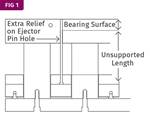Ejector Delay Unit for Two-Stage Demolding
Hasco’s Z1725/… ejector delay unit enables two-stage ejector demolding so sprue and part are cleanly separated through a coordinated ejector movement.
Hasco’s new Z1725/... ejector delay unit enables efficient demolding and separation of sprues via two-stage ejector demolding where the consistent delay is ensured by an individual pocket depth and the ejector assembly. Hasco says this enables the sprue and molded part to be cleanly separated from one another through a coordinated ejector movement.
Hasco says the new delay unit not only improves process reliability but also the quality of the end products. Production downtimes are reduced and maximum flexibility provided because the units can be used without any minimum stroke requirements. Ejector sizes from 2 to 5.9 mm enable a variety of applications in different production processes.
The ejector delay unit works by transferring axial forces through friction between the plastic sleeve and the drill-hole wall. This friction force can be adjusted by a conical, self-securing screw and adapted to the specific requirements. The plastic sleeve should sit approximately 3-mm deep in the location hole. The precise position of the ejector pin is secured by a flattened circular pocket. The desired delay is integrated into the pocket depth of the ejector package. The ejector delay can also be retrofitted into existing tools.

Hasco’s Z1725/… ejector delay unit enables two-stage ejector demolding. Source: Hasco
Related Content
-
Back to Basics on Mold Venting (Part 1)
Here’s what you need to know to improve the quality of your parts and to protect your molds.
-
How to Design Three-Plate Molds: Part 5
There are many things to consider, and paying attention to the details can help avoid machine downtime and higher maintenance costs. In this installment, the focus is on design and placement of sucker/puller pins.
-
Hot Runners: How to Maintain Heaters, Thermocouples, and Controls
I conclude this three-part examination of real-world problems and solutions involving hot runners by focusing on heaters, thermocouples, and controls. Part 3 of 3.













